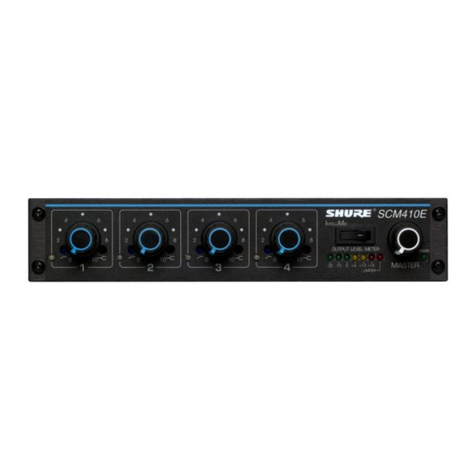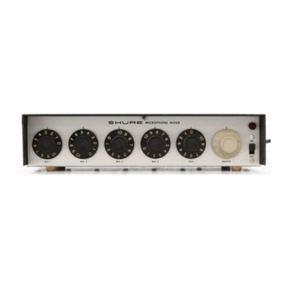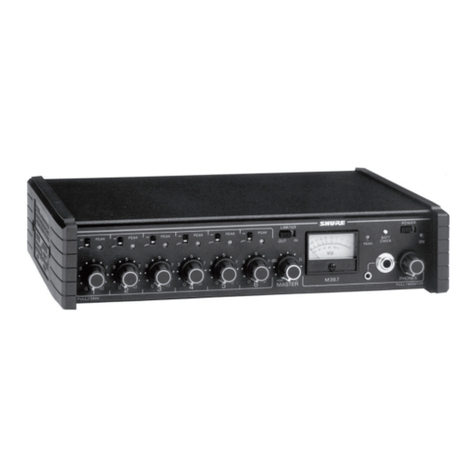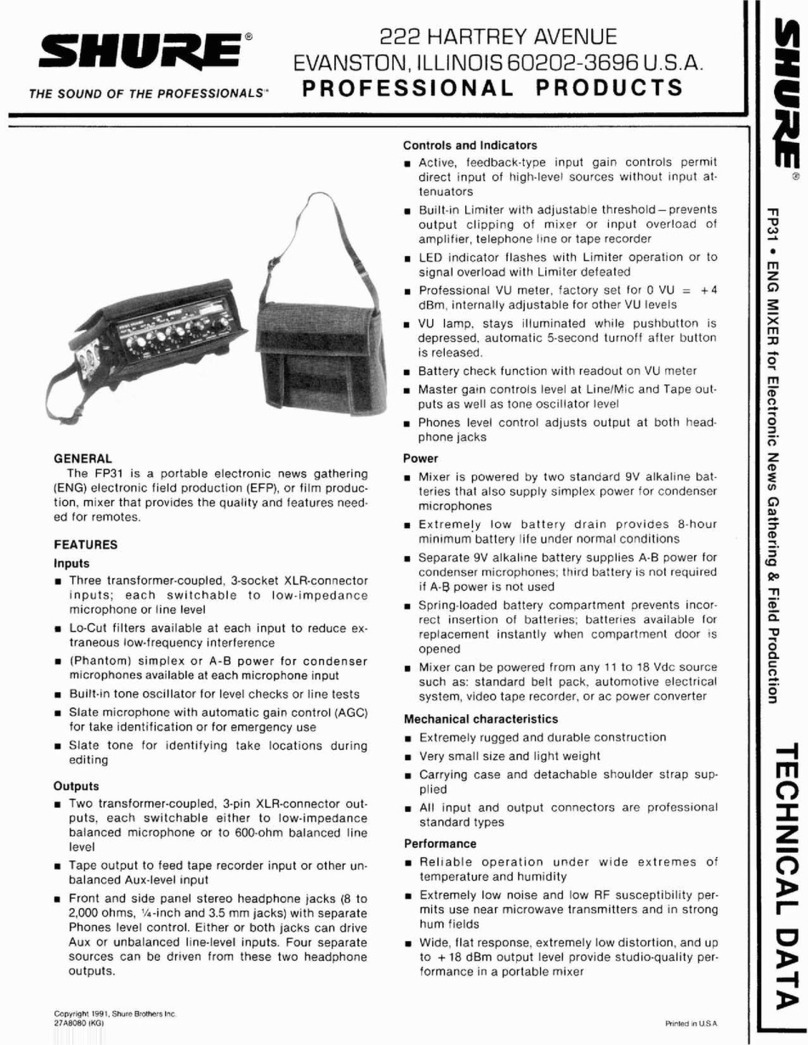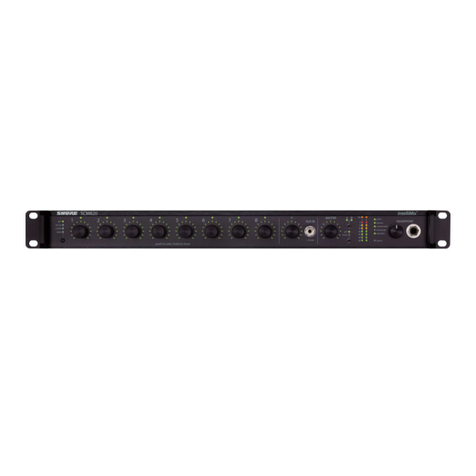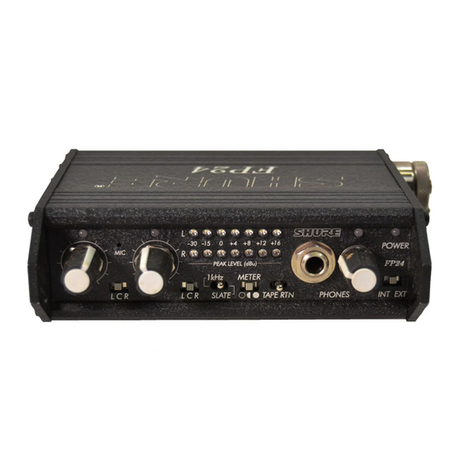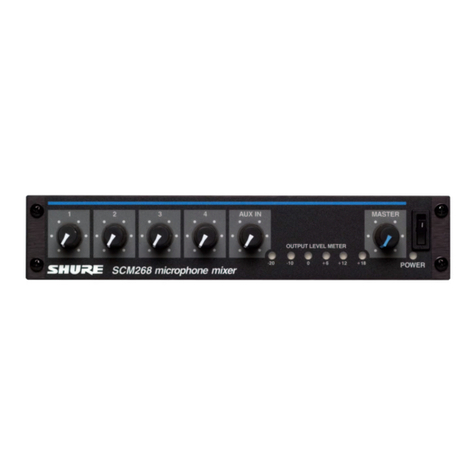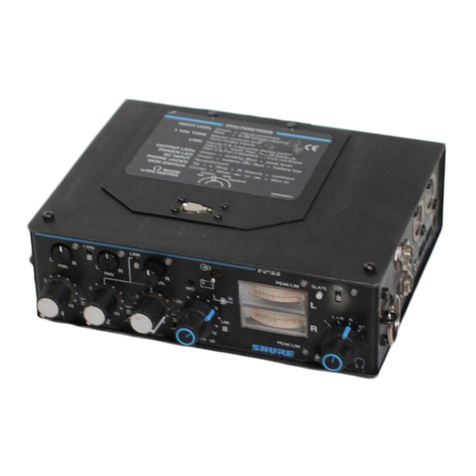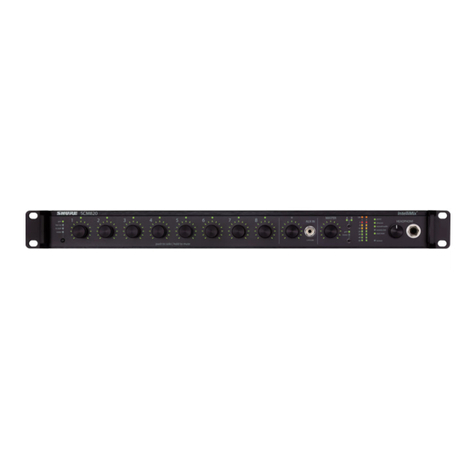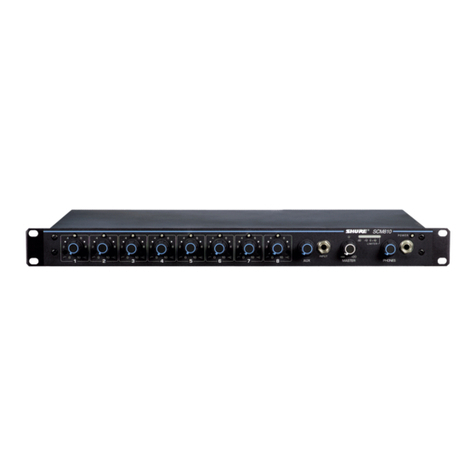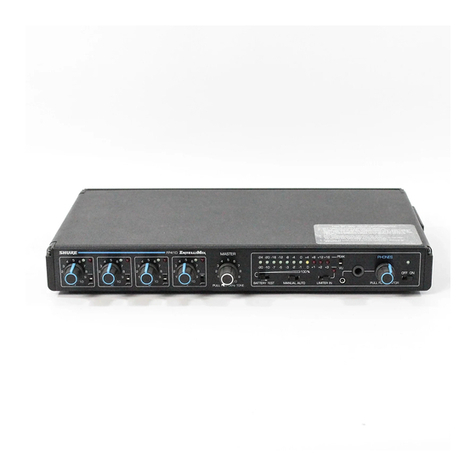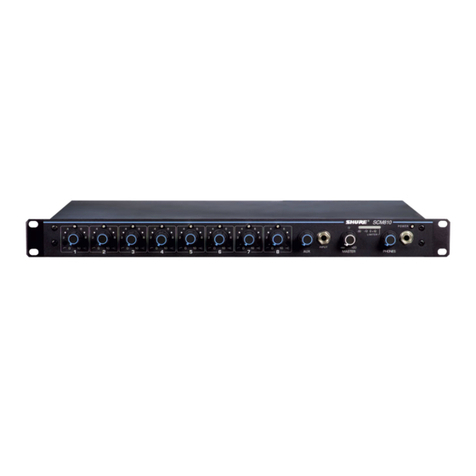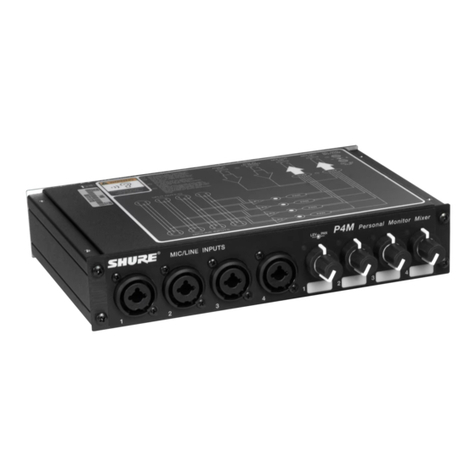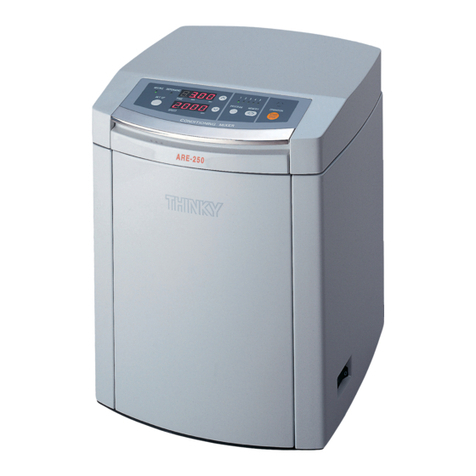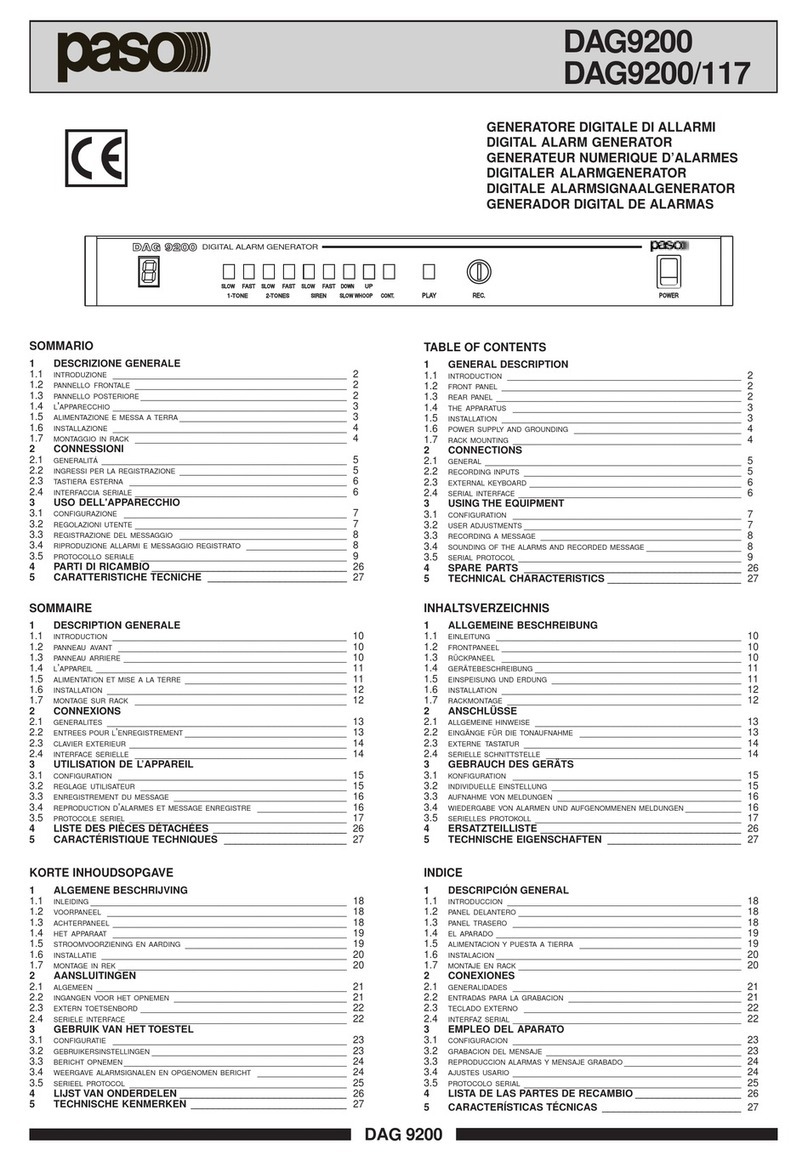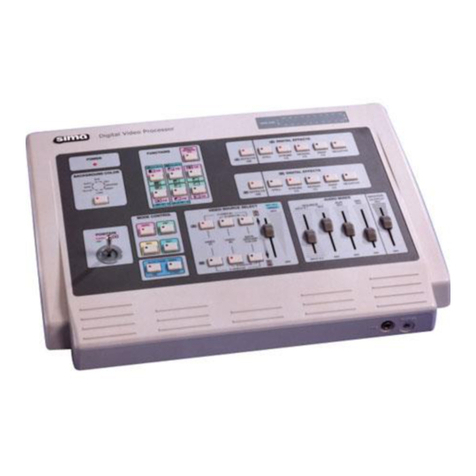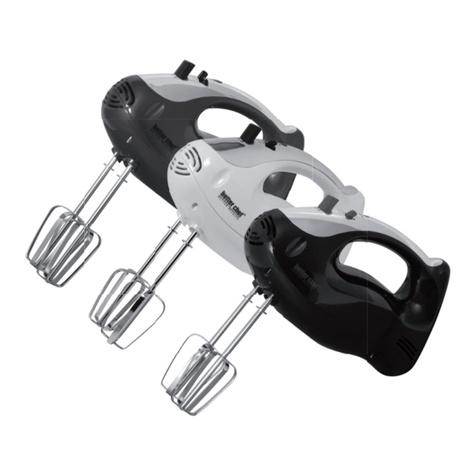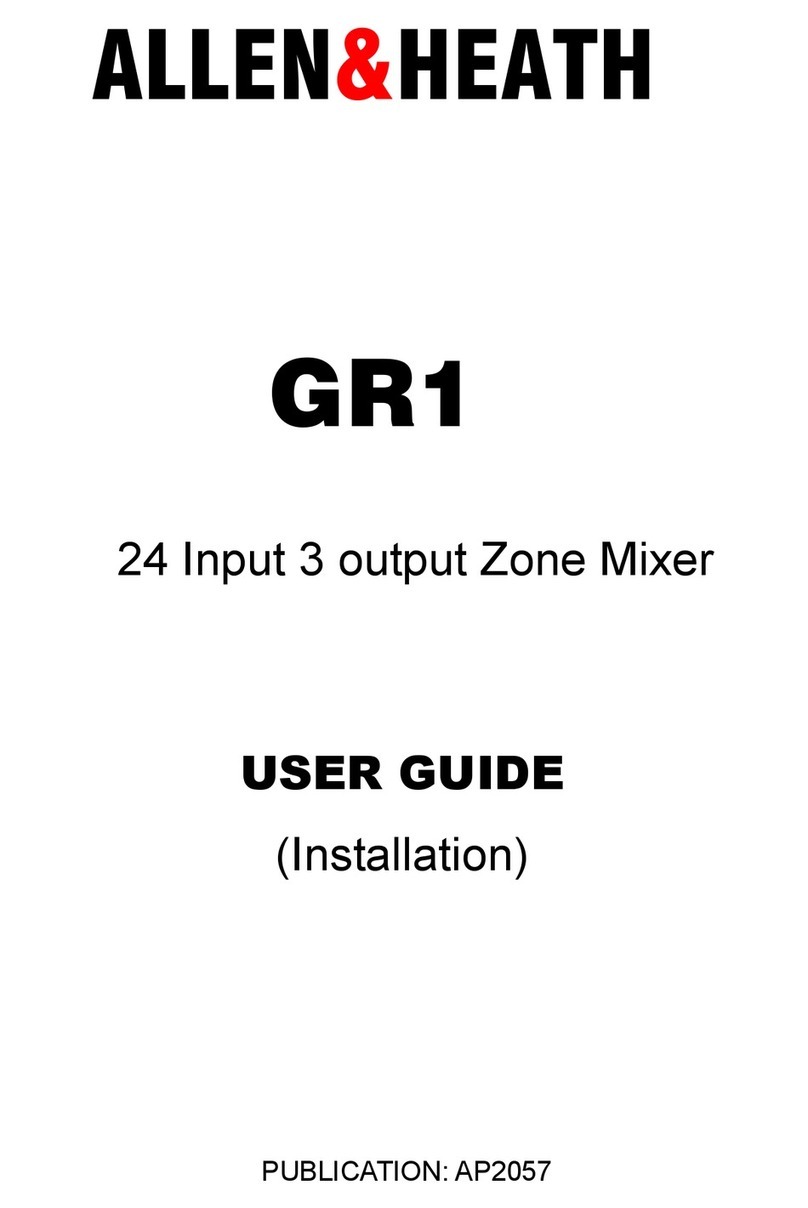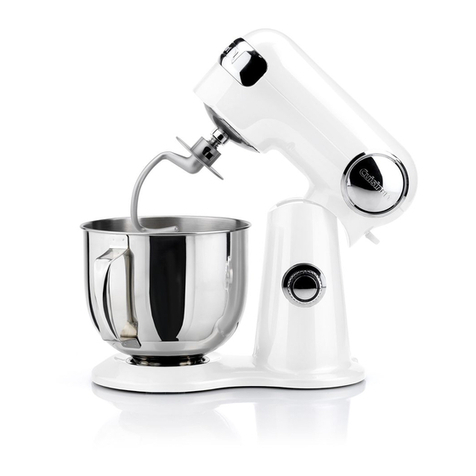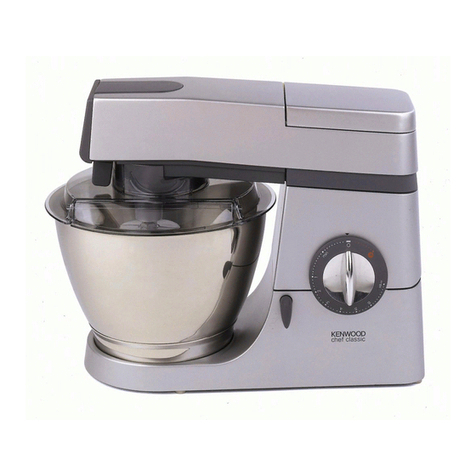
9
SPECIFICATIONS
Measurement Conditions (unless otherwise specified): Line volt-
age 120 Vac, 60 Hz (SCM810) or 230 Vac, 50 Hz (SCM810E);
full gain; 1 kHz, one channel activated; source impedances: Mic
150Ω, Line 150 Ω; terminations: Line 10 kΩ, Phones 300 Ω (tip-
sleeve and ring-sleeve), Direct Out 10 kΩ; Auto mode, equaliza-
tion controls adjusted for flat response
Frequency Response (Ref 1 kHz, channel controls centered)
50 Hz to 20 kHz ±2 dB; -3 dB corner at 25 Hz
Voltage Gain (typical, controls full clockwise)
Output
Input Line Head-
phones Direct Out
Low-impedance
mic (150 Ω)80 dB 88 dB 34 dB
Line 40 dB 48 dB –6 dB
Aux 44 dB 52 dB —
Send/Return 20 dB 28 dB —
Inputs
Impedance
Input Designed
for use with Actual
(typical) Input
Clipping
Level
Mic 19-600 Ω1.6 kΩ-15 dBV
Line ≤2 kΩ10 kΩ+22 dBV
Aux ≤2 kΩ10 kΩ+22 dBV
Send/Return ≤2 kΩ10 kΩ+18 dBV
Outputs
Impedance
Output Designed
for use with Actual
(typical) Output
Clipping
Level
Line >600 Ω60 Ω+18 dBV
Head-
phones 8-200 Ω,
60 Ωrecom-
mended
300 Ω+12 dBV
Direct Out >2 kΩ1 kΩ+18 dBV
Send/Return >2 kΩ1 kΩ+18 dBV
Total Harmonic Distortion
<0.1% at +18 dBV output level, 50 Hz to 20 kHz (through 20
Hz-20 kHz filter; Input 1 and Master at 5, all other controls full
counterclockwise)
Hum and Noise
Equivalent Input Noise -125 dBV (150 Ωsource;. . . . . . . . .
through 400 Hz - 20 kHz filter)
Equivalent Input Hum and Noise . . . . . . . . . . . . . . . . . . . . . . .
-123 dBV (150 Ωsource; through
20 Hz - 20 kHz filter)
Output Hum and Noise (through 20 Hz to 20 kHz filter; channel
controls full counterclockwise))
Master full counterclockwise -90 dBV. . . . . . . . . . . . . . . . .
Master full clockwise -70 dBV. . . . . . . . . . . . . . . . . . . . . . . .
Common Mode Rejection
>70 dB at 1 kHz
Polarity
Mic/Line, Send inputs to all outputs are non-inverting; Aux in-
put to all outputs is inverting
Input Channel Activation
Attack Time 4 ms. . . . . . . . . . . . . . . . . . . . . . . . . . . . . . . . . . . . .
Hold Time 0.4 s (switchable to 1.0 s). . . . . . . . . . . . .
Decay Time 0.5 s. . . . . . . . . . . . . . . . . . . . . . . . . . . . . . . . . . . .
Off-Attenuation
15 dB (switchable to ∞)
Overload and Shorting Protection
Shorting outputs, even for prolonged periods, causes no dam-
age. Microphone inputs are not damaged by signals up to 3 V;
Line and Monitor inputs by signals up to 20 V
Equalization
Low-frequency 6 dB/octave cut, adjustable. . . . . . . . . . . . . . corner from 25 to 320 Hz
High-frequency ±6 dB at 5 kHz, ±8 dB at. . . . . . . . . . . . . . . . 10 kHz, shelving
Limiter
Type Peak. . . . . . . . . . . . . . . . . . . . . . . . . . . . . . . . . . . . . . . . . . .
Threshold Switchable: off, +4, +8, +16. . . . . . . . . . . . . . . . . . (dBm at output)
Attack Time 2 ms. . . . . . . . . . . . . . . . . . . . . . . . . . . . . . . . . . . . .
Recovery Time 300 ms. . . . . . . . . . . . . . . . . . . . . . . . . . . . . . . .
Indicator Lights red when limiting occurs. . . . . . . . . . . . . .
Input LEDs
Green on channel activation, red at 6 dB below clipping
Phantom Power
46 Vdc open-circuit through 6.8 kΩseries resistance per DIN
45 596
Operating Voltage
SCM810: 120 Vac rated nominal (see Voltage Selection for
230 Vac operation), 50/60 Hz, 200 mA
SCM810E: 230 Vac rated nominal (see Voltage Selection
for 120 Vac operation), 50/60 Hz, 100 mA
Temperature Range
Operating 0°to 60°C (32°to 140°F ). . . . . . . . . . . . .
Storage -30°to 70°C (-20°to 165°F). . . . . . . . . . . . . . .
Overall Dimensions
44.5 mm H x 483 mm W x 317 mm D
(13/4x 19 x 121/2inches)
Net Weight
4.3 kg (9 lb 9 oz)
Certifications
SCM810: Listed by Underwriters Laboratories, Inc., listed as
Certified by Canadian Standards Association; SCM810E:
Conforms to European Union directives, eligible to bear CE
marking; VDE GS-Certified to EN 60 950; meets European
Union EMC Immunity Requirements (EN 50 082–1, 1992).
Replacement Parts
Block Connector 95A8580. . . . . . . . . . . . . . . . . . . . . . . . . . . .
Knob, Master & Phones (white) 95A8238. . . . . . . . . . . . . . . .
Knob, Channel Gain (blue) 95B8238. . . . . . . . . . . . . . . . . . .
Line (Power) Cord (SCM810) 95A8389*. . . . . . . . . . . . . . . .
Line (Power) Cord (SCM810E) 95A8247*. . . . . . . . . . . . . . .
Link Cable 95A8889. . . . . . . . . . . . . . . . . . . . . . . . . . . . . . . . . .
*For systems requiring other mains connectors, obtain a power cord with
an IEC 320 type mating connector for connection to the SCM810, and an
appropriate plug on the other end for connection to the mains. The sup-
plied cord uses Harmonized IEC Cordage with color coding as follows:
Brown = Line, Blue = Neutral, Green/Yellow = Ground.
